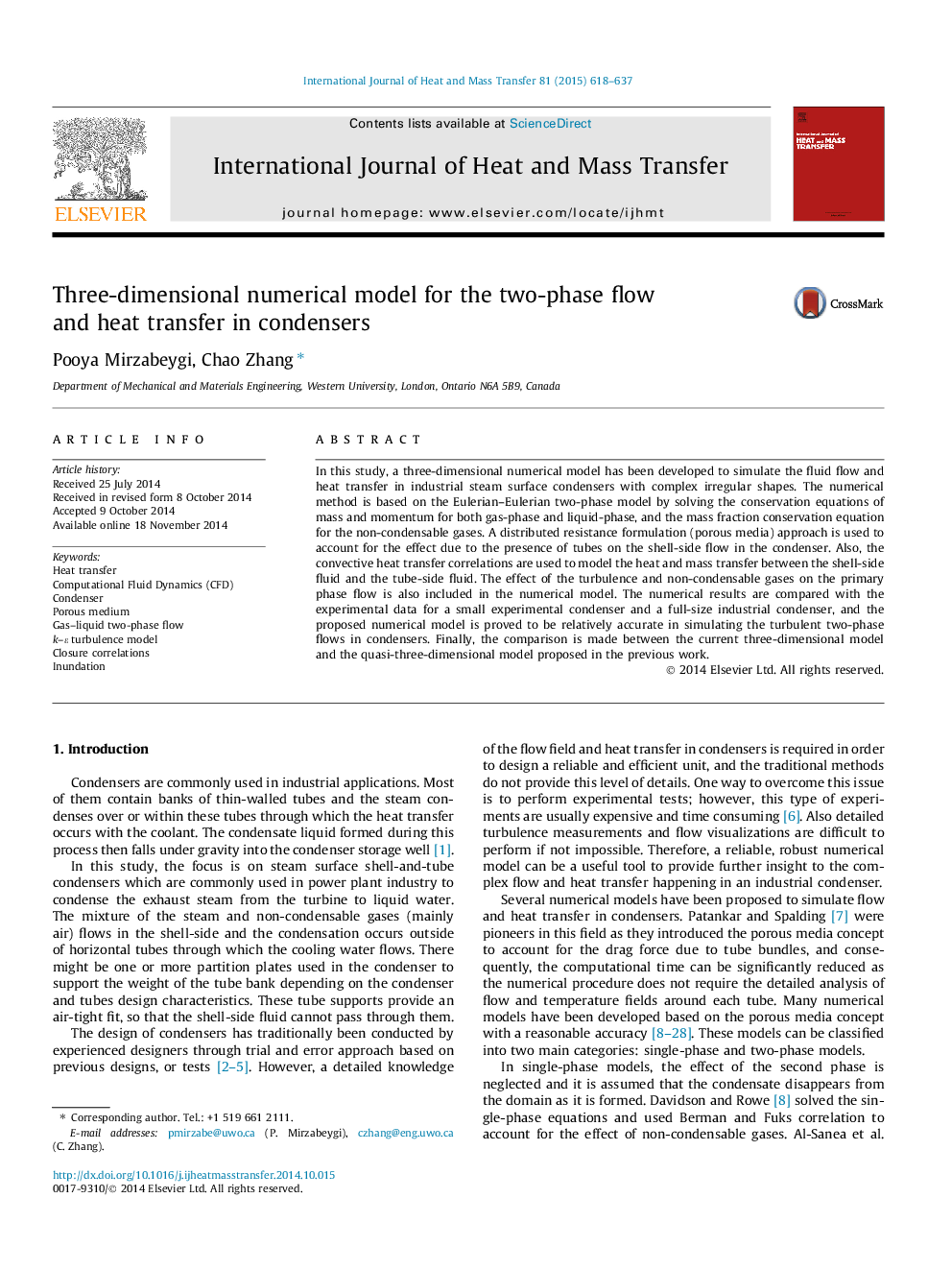| کد مقاله | کد نشریه | سال انتشار | مقاله انگلیسی | نسخه تمام متن |
|---|---|---|---|---|
| 656866 | 1458061 | 2015 | 20 صفحه PDF | دانلود رایگان |
عنوان انگلیسی مقاله ISI
Three-dimensional numerical model for the two-phase flow and heat transfer in condensers
ترجمه فارسی عنوان
مدل عددی سه بعدی برای جریان دو فاز و انتقال حرارت در خازن ها
دانلود مقاله + سفارش ترجمه
دانلود مقاله ISI انگلیسی
رایگان برای ایرانیان
کلمات کلیدی
ترجمه چکیده
در این مطالعه یک مدل عددی سه بعدی برای شبیه سازی جریان سیال و انتقال حرارت در خازن های صنعتی بخار با اشکال نامنظم پیچیده ایجاد شده است. روش عددی مبتنی بر مدل دو مرحلهای اویلر-اویلر است که با حل معادلات حفاظت از جرم و جرم برای هر دو فاز گاز و فاز مایع و معادله حفاظت از انبساط جرم برای گازهای غیر قابل جذب می باشد. روش ترکیب مقاومت توزیع شده (رسانه متخلخل) برای تأثیر تأثیر به دلیل حضور لوله ها در جریان جریان پوسته در کندانسور استفاده می شود. همچنین، همبستگی انتقال حرارت کنترلی برای مدل انتقال گرما و جرم بین سیال سمت چپ و سیال سمت لوله استفاده می شود. اثر گازهای آشفته و غیر متراکم بر جریان فاز اولیه نیز در مدل عددی گنجانده شده است. نتایج عددی با داده های تجربی برای یک کندانسور آزمایشی کوچک و یک خازن صنعتی کامل اندازه گیری شده است و مدل عددی پیشنهاد شده در شبیه سازی جریان دو فاز آشفته در خازن ها نسبتا دقیق است. در نهایت، مقایسه ای بین مدل سه بعدی جاری و مدل شبه سه بعدی ای که در کار قبلی ارائه شده است، مقایسه می شود.
موضوعات مرتبط
مهندسی و علوم پایه
مهندسی شیمی
جریان سیال و فرایندهای انتقال
چکیده انگلیسی
In this study, a three-dimensional numerical model has been developed to simulate the fluid flow and heat transfer in industrial steam surface condensers with complex irregular shapes. The numerical method is based on the Eulerian-Eulerian two-phase model by solving the conservation equations of mass and momentum for both gas-phase and liquid-phase, and the mass fraction conservation equation for the non-condensable gases. A distributed resistance formulation (porous media) approach is used to account for the effect due to the presence of tubes on the shell-side flow in the condenser. Also, the convective heat transfer correlations are used to model the heat and mass transfer between the shell-side fluid and the tube-side fluid. The effect of the turbulence and non-condensable gases on the primary phase flow is also included in the numerical model. The numerical results are compared with the experimental data for a small experimental condenser and a full-size industrial condenser, and the proposed numerical model is proved to be relatively accurate in simulating the turbulent two-phase flows in condensers. Finally, the comparison is made between the current three-dimensional model and the quasi-three-dimensional model proposed in the previous work.
ناشر
Database: Elsevier - ScienceDirect (ساینس دایرکت)
Journal: International Journal of Heat and Mass Transfer - Volume 81, February 2015, Pages 618-637
Journal: International Journal of Heat and Mass Transfer - Volume 81, February 2015, Pages 618-637
نویسندگان
Pooya Mirzabeygi, Chao Zhang,
